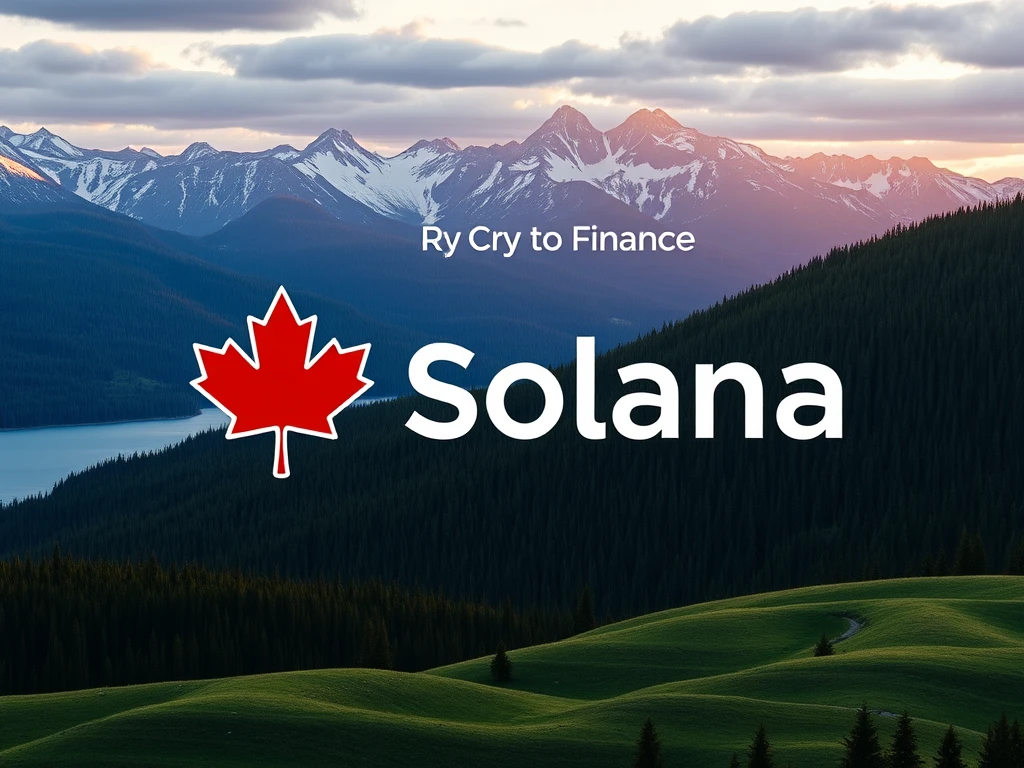Unlocking Yield: Canada’s Spot Solana ETFs with Staking Drive Crypto Innovation

Are you looking for simpler ways to access the cryptocurrency market and potentially earn passive income? The launch of spot Solana ETFs with staking in Canada represents a significant development in crypto investment, offering traditional investors regulated access to the Solana ecosystem and the potential for yield generation. This move positions Canada as a leader in crypto innovation, bridging the gap between traditional finance and the dynamic world of decentralized assets.
What Exactly is a Spot Solana ETF?
A Spot Solana ETF is an investment fund traded on a traditional stock exchange that directly holds Solana (SOL) tokens. This structure allows investors to gain exposure to SOL’s real-time market price without the complexities of managing crypto wallets or using specialized trading platforms. Instead of speculating on future prices via derivatives, a spot ETF tracks the performance of the actual underlying asset.
- **Direct Exposure:** The ETF’s value is tied directly to the current market price of SOL.
- **Regulatory Framework:** Traded on regulated exchanges, providing a familiar environment for traditional investors.
- **Simplicity:** Offers an easy way to add Solana exposure to a standard investment portfolio.
Unlike futures-based products, a Spot Solana ETF provides more transparent pricing that closely reflects SOL’s supply and demand dynamics on the blockchain. This distinction is crucial for investors seeking direct correlation to the asset’s performance.
Canada Leads the Way in Crypto Innovation
On April 16, 2025, Canada made history by launching the world’s first spot Solana ETFs that incorporate staking. Approved by the Ontario Securities Commission (OSC), four asset managers — 3iQ, Purpose, Evolve, and CI Financial — received approval for their funds on the Toronto Stock Exchange. This move underscores Canada’s proactive approach to integrating digital assets into its financial system.
These Canadian ETFs hold actual SOL tokens, secured through institutional-grade cold storage. Each fund follows a different index, but all are built for long-term investment in Solana. By including staking, these funds offer investors an active way to potentially earn returns within a regulated structure and secure custody services.
How Does Solana Staking Boost Returns?
The inclusion of Solana staking is a key differentiator for these Canadian ETFs. Staking involves locking up SOL tokens to support the Solana network’s operations and security. In return, the network issues rewards to participants. These ETFs partner with staking providers (like TD Bank in one instance) to delegate a portion of their held SOL assets for staking.
These staking rewards are then passed on to ETF shareholders. Estimates suggest this feature could boost annual returns for investors by 2%-3.5%, in addition to SOL’s price appreciation. While management fees for these ETFs range from 0.15% to 1%, the potential staking yield can help offset these costs over time. This yield generation capability makes the ETFs more attractive, especially considering Solana often offers competitive staking yields compared to other proof-of-stake networks like Ethereum.
Spot Solana ETFs: Unlocking Passive Crypto Investment
Canada’s approval of spot Solana ETFs with staking is a significant step towards enabling passive crypto investment opportunities within a regulated framework. Traditional investment products in other regions, like European crypto ETPs or US futures ETFs, typically don’t offer staking yield.
Allowing staking within the ETF structure addresses investor demand for yield from proof-of-stake assets. As staking is fundamental to the value proposition of tokens like SOL, its inclusion makes these ETFs more appealing to traditional investors seeking income-generating potential from digital assets. This move reinforces Canada’s pioneering role, following its launch of the first spot Bitcoin and Ethereum ETFs in 2021.
While promising, it’s important to note that staking carries risks, such as potential losses from validator penalties (slashing) or network issues, which could impact returns.
What This Means for the US Market and Beyond
Canada’s bold step in approving Spot Solana ETF products with staking could influence regulatory decisions in other countries, particularly the United States. With the SEC currently reviewing numerous crypto-related ETF applications, including those for altcoins and leveraged products, Canada’s experience offers a valuable case study.
The launch of Solana futures on the CME in March 2025 is seen by some as a potential precursor to a US spot SOL ETF approval. However, the US regulatory landscape is more fragmented than Canada’s, involving multiple agencies like the SEC and CFTC, which can complicate policy development.
Canada’s move signals a growing acceptance of crypto-powered finance among regulators and confidence in alternative layer-1 networks like Solana. Whether the US follows Canada’s lead on non-Bitcoin spot ETFs, especially those with staking, remains a key question for the global crypto investment market.
Conclusion: A New Era for Crypto Investment Access
The introduction of spot Solana ETFs with staking in Canada marks a pivotal moment for crypto innovation and mainstream adoption. By offering direct SOL exposure and the potential for staking yield within a regulated and secure structure, these products provide traditional investors with an accessible pathway to participate in the Solana ecosystem. While risks inherent to both ETFs and staking exist, Canada’s pioneering regulatory approach sets a precedent that could shape the future of crypto investment products globally, potentially paving the way for similar offerings in other jurisdictions.









